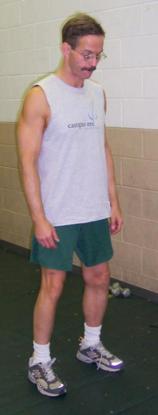
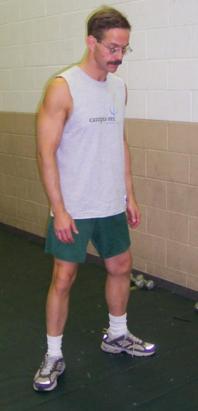
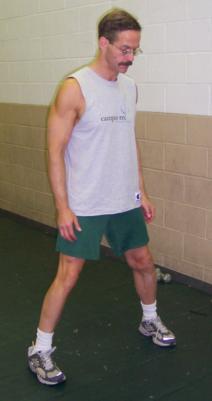
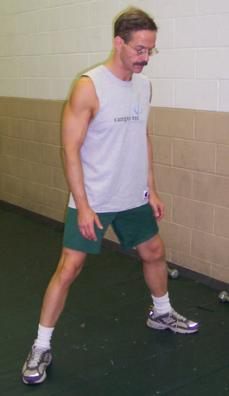


My dictionary
defines a stance as
the attitude or position of a standing person or animal, especially the position assumed by an athlete
preparatory to action.
This is ok. For us, a stance is anytime the soles or balls of your feet are on the ground. Stances serve many
functions. One of the most important is getting you aware of how you are drawing power from the ground.
It has been said before that all power comes from the ground in a martial art. This is true. Most
people have never had to move another and so are woefully off-balance when they try. This is normal
and our stance training is specifically to get you able to do this.
A few definitions are needed. By the length of your stance we mean the distance between your feet along the axis you are facing. The width of your stance is the distance perpendicular to this. A stance is deep if your center of gravity is lower, i.e. your legs are more bent, otherwise it is shallower. When you step and thereby move we refer to this as walking in stances. Walking is a good and fundamental exercise.
A few other concepts refer to structure. We define a path to be an alignment of the skeleton to transmit force from one point to another through the body. For instance, if you push on a wall with one hand and lift a foot, there is a path through your arm, across your back and down your leg. Any path the has one end on the ground is called root. So to do a bench press, you must have proper root, indeed, you can get injured if you are not in the correct position. Almost the only thing that a beginner should be concerned with is developing root. Root comes from the correct angle of the hips and legs, so this depends on the incoming forces and how you meet them. Reread that line. Do it again. You cannot have root that is independent of the situation. Varying the height of your stance varies the angles you need to maintain root. The best way to develop it is by lots of practice alone and then hands-on experience. This is not to say that self practice is wrong, but is merely insufficient by itself.
How deep is deep? In a stance where you are standing, as opposed to where at least one knee is on the ground, your thighs could be parallel to the ground. Deeper than this is probably not possible. You should work initially with stances as deep as you can, then work at various heights. All of this is aimed at getting your leg and hip muscles to work through a full range of motion equally. In practice, stance depth is quite dynamic and will be determined by any number of factors. Power in people's legs drops off dramatically as the depth increases, so it is important that you practice various depths including far deeper than you normally would go so that you have depth to burn if needed.
For fighting, your base should rarely be wider than a normal stride, but being able to move fluidly within this area while maintaining balance and power is very tricky. Stances are among the easiest ways to train this stability. In practice, the way power is coming through your feet determines the stance and the difference between them might not be visible to the naked eye. However, being aware of how you draw power has to be built up.
 |
 |
 |
 |
 |
 |
Walking.
 |
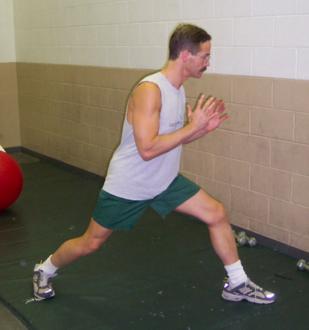 |
 |
 |
How to turn. Take your rear foot and move it to the opposite rear corner. For example, if your right leg is back, you would move it to your left-rear corner. You will need to drop your center of gravity. You are now in kosa dachi. Turn 180 degrees.
Where to use it. A forward stance is extremely strong and stable for forces coming to the front of the body. We normally face out opponent when engaged, so you will be in some variation of a front stance. Note: A front stance for stability training, as shown here, is vastly exaggerated. In actual use it looks just about like a boxer's stance. It is the distribution of the weight on the feet, not the depth that makes this a front stance.
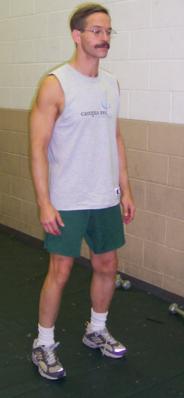 |
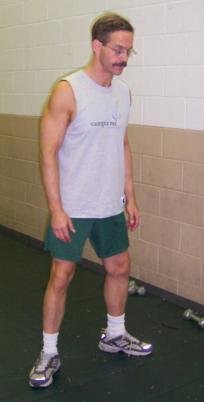 |
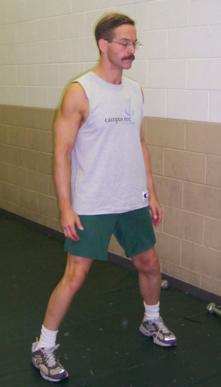 |
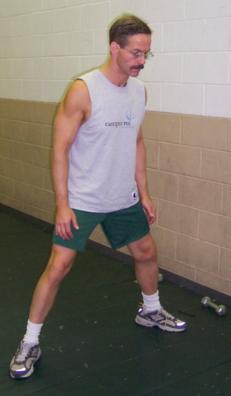 |
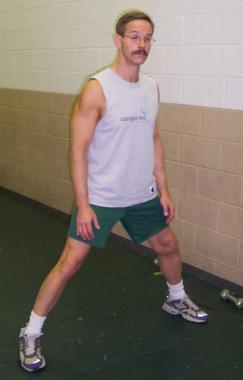 |
 |
Walking.
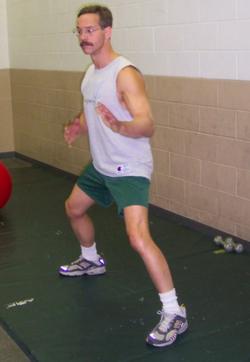 |
 |
 |
 |
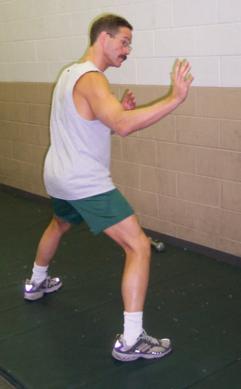 |
Turning. This is really easy in a horse stance. Just look the other way, turn and repositioning your hands as needed.
Where to use it. A horse stance is most stable for forces coming from the side. This is an application of otoshi or dropping. It also useful to be in this position and use the legs to drive you up from underneath your opponent. Many karate systems use some variation of this as a fighting stance. This doesn't work for us because we do attack legs and it is very hard to defend against a leg kick in this position. You might end up in this position going from or heading to another and it is extremely useful in this way.
Description.
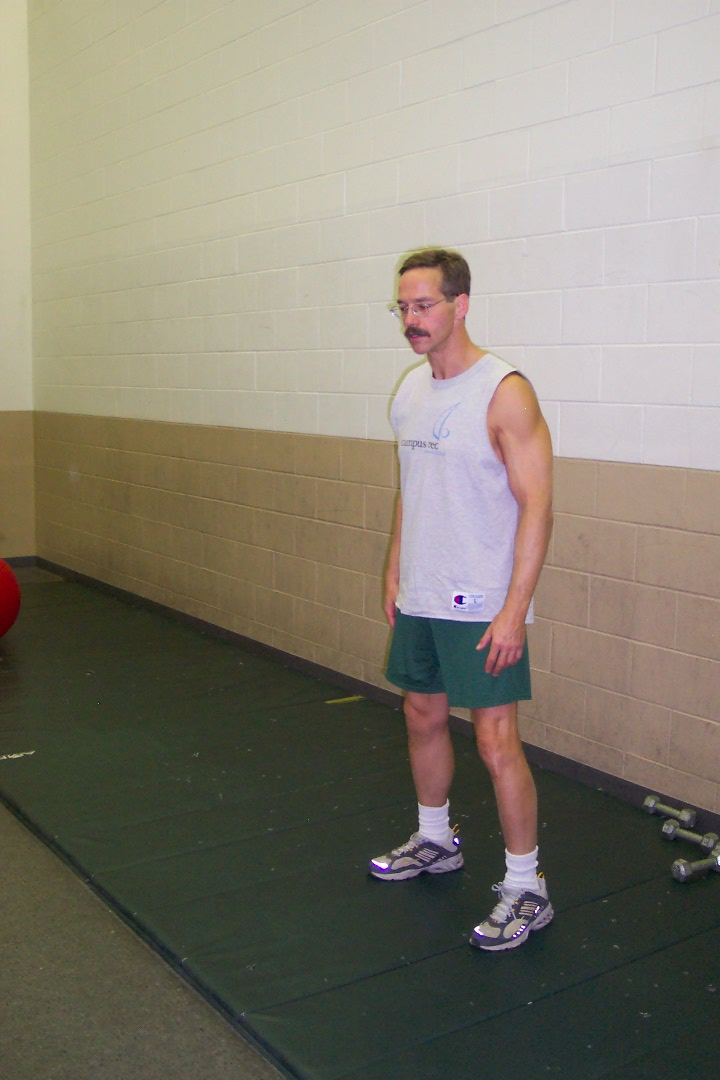 |
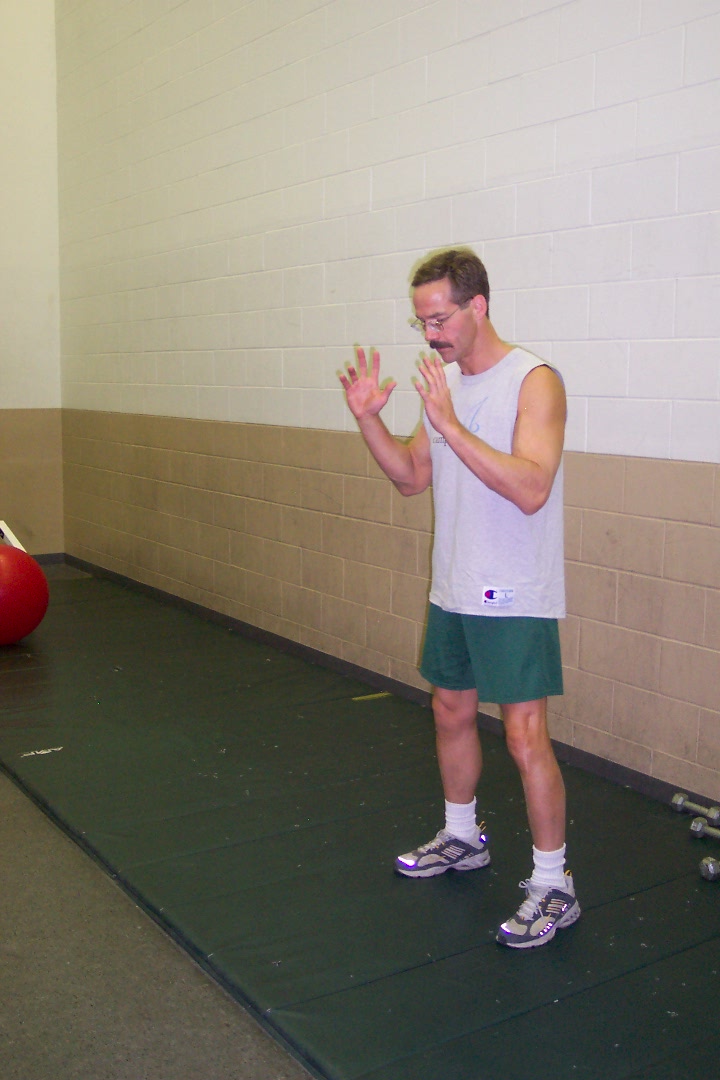 |
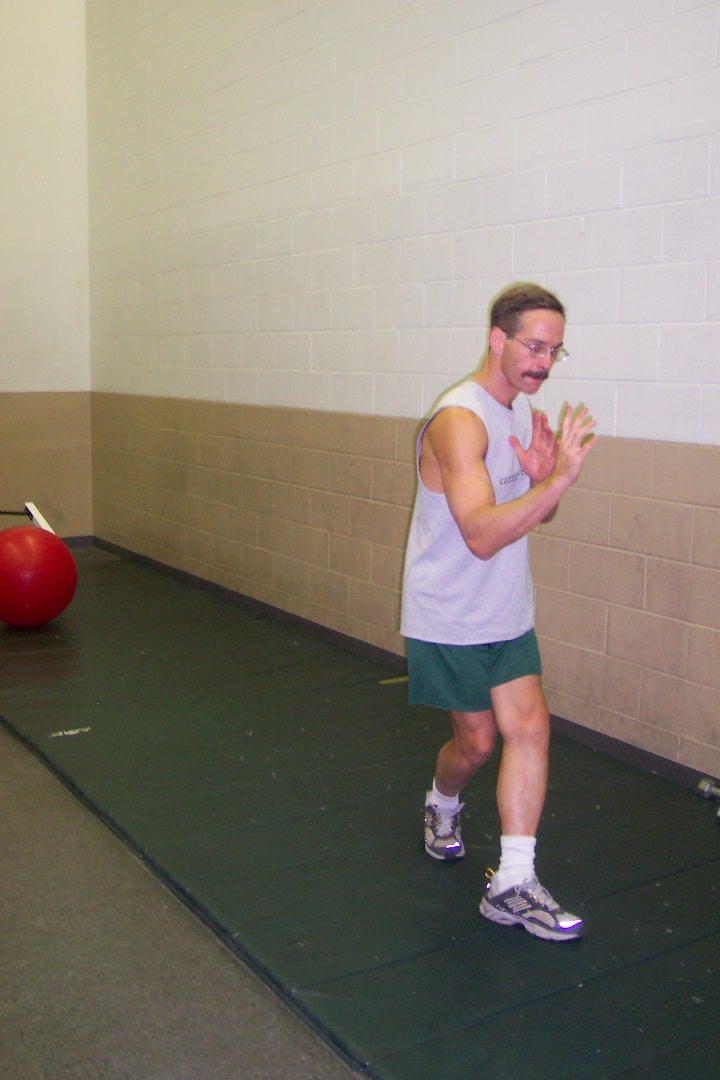 |
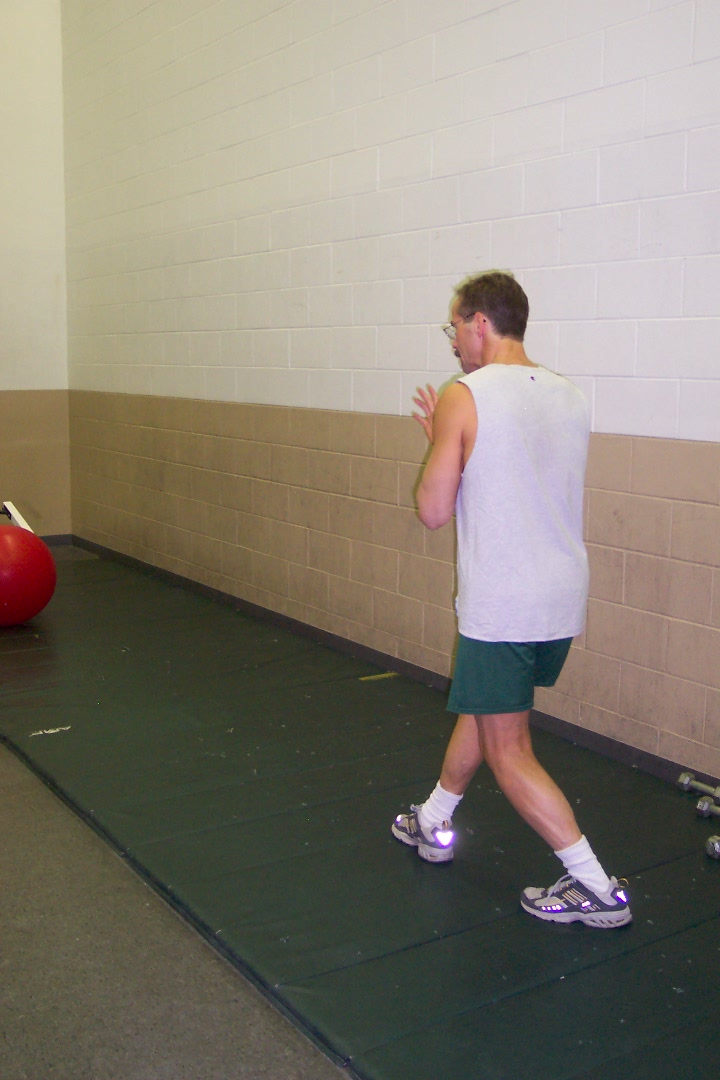 |
Walking. One does not normally walk in kosa dachi but uses it as part of other movements. If you insist though, you pull your rear leg up to your front and step out as if in a front stance, pivoting the additional 45 degrees at the end of the step.
Turning. To turn in a kosa dachi, turn 180 degrees, being sure that your preserve form correctly.
Where to use it. This is used either in transition from one stance to another or when it is necessary to move your opponent along a line 45 degrees to your front. It is useful for drawing your opponent off balance and for dropping your weight straight down ("corkscrewing" as we sometimes call it since it mechanically is a screw). It is most stable along the axis of your front and least stable at 90 degrees to this. This stance seems weird at first, but is actually extremely useful.
Description.
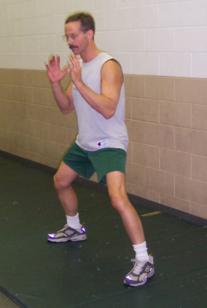 |
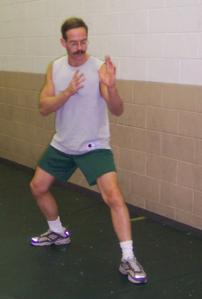 |
Walking.
 |
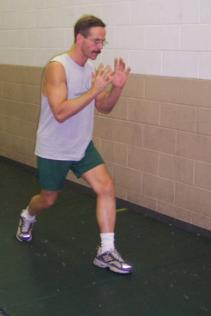 |
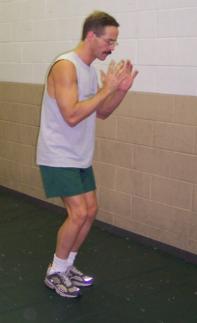 |
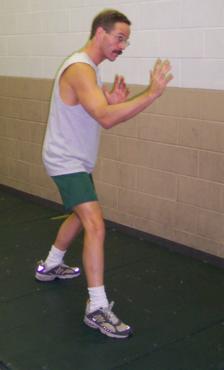 |
Turning. We will describe this assuming your right foot is the rear foot. Slide your right foot behind you, so that it reaching past your left side. You should have the ball of your rear foot on the floor and the heel up. Turn to your right. You should now be facing the other way. Be sure to preserve form.
When to use it. This stance is used for many things: When you must drop your weight straight down It is also good for drawing your opponent back towards you. It is most stable along the front-back axis.
Description. Start facing the front. Step to 7 o'clock with your right foot. Drop to your right knee, so that you leg is about 90 degrees to left leg. The ball of your right foot is still on the floor and your feet and knee make a triangle. A common error is to slide the leg straight back and end up without a stable base. This is called han tachi 1, and the number counts how many knees are down.
Walking: Shiko Walking in this stance is called "knee walking" or sometimes the "samurai walk". The japanese is shiko It is easiest to describe this by example. Assume that your right foot is back. To advance, rock down to your left knee as you bring your right leg up, putting the sole of your right foot on the ground. The hips must rotate so that your belt knot is facing 11 o'clock. You are now in han tachi on the other side. As you move, you should imagine that your ankles as loosely bound together so that they cannot get apart.
A sumarai was not allowed to stand presence of his master and had to stay seated in seiza for many hours a day. Walking in shiko was therefore the standard. Shiko occupies a special place in Japanese culture and signifies great respect. This accounts for the (to Americans, at least) puzzling behavior in many Japanese movies set in the past. There is often some scene where the protagonist has finally earned the respect of his fellows and they all drop into seiza and then shiko to him and bow formally.
A really traditional dojo requires that all students be in seiza any time they have not been specifically told to stand by the instructor. In fact, you should drop into seiza as soon as you step onto the mat and shiko to your position for class.
Turning. Pivot 180 degree by raising your rear knee as you drop your forward knee to the ground.
Use. Anytime that you are not in a standing position, this is a useful stance. If you end up on the floor your first order of business is either rolling to a standing position or getting in this stance. This will free up your hands which is crucial, and allow you to stand or be ready for defense. It also allows you to be stable while not standing. Many finishing floor pins end in han tachi with either one or both knees on the ground.
Description. This is virtually identical to the one-kneed version. You go into the one-kneed version, then tuck the forward leg underneath you. Both knees are on the floor and are at between 45 degree and 90 degrees to each other. They should not be together. Since the balls of your feet are on the floor, this is considered to be a "live" stance, i.e., one from which you can defend yourself. really the only difference between this and seiza is having the balls of both feet on the ground. For women, the knees spread in this stance. This is called han tachi 2 because both knees are down.
Walking. This is shiko, the same as in the one-kneed version.
Turning. Raise to one-kneed han tachi and follow the instructions there.
Use. Even more stable that the one-kneed version, this figures prominently in many floor pins.
Standing back up politely. If you want to stand from this position in a non-threatening manner, you do not simply go into one-kneed han tachi. This would mean that you are advancing and could be seen as an aggressive move. Therefore, bring the ball of your right foot (there is no choice in this matter, since as a samurai you need to keep the left-hand side of your body free to draw your sword) up in line with your left heel. Rock back onto your left heel and stand straight up.
Description. From han tachi with both knees on the floor, raise up slightly, put the tops of your feet on the floor and sit on your heels. Do not cross your toes, or the Japanese will tell you that you are inhibiting your ki. Men sit with the legs spread from 45 degrees to 90 degrees, but that is considered immodest for women, who should sit with their knees together.
Walking. Raise into han tachi and shiko.
Turning. This is sitting, but if you had to, raise into han tachi and turn.
Use. In addition to being the "working position" of a samurai, this is used for all formal situations where you are to be seated. If in doubt, sit in seiza. This is also quite useful in various floor pins.